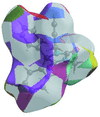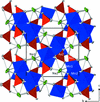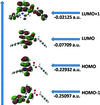issue contents
July 2019 issue

Cover illustration: Polyoxometallates (POMs) show a wide variety of applications and can be used to synthesize new hybrid organic-inorganic materials. The crystal structure of hexakis(2-methyl-1H-imidazol-3-ium) heptamolybdate 2-methyl-1H-imidazole disolvate dihydrate contains an [Mo7O24]6- anion, six (C4H7N2)6+ cations, two neutral C4H6N2 molecules and two water molecules of crystallization in the asymmetric unit. The components are linked by O-H O, N-H
O, N-H O, N-H
O, N-H N and weak C-H
N and weak C-H O interactions. See: Sarr, Mbaye, Diallo, Diop, Sidibe & Michaud [Acta Cryst. (2019). E75, 1001-1004].
O interactions. See: Sarr, Mbaye, Diallo, Diop, Sidibe & Michaud [Acta Cryst. (2019). E75, 1001-1004].
research communications
Download citation


Download citation


In the title compound, C20H18NO3P, the C=O and P=O groups of the carbacylamidophosphate (CAPh) fragments are located in a synclinal position relative to each othe. The N—H group is involved in the formation of an intramolecular hydrogen bond.
CCDC reference: 1918613
Download citation


Download citation


The molecule has an E configuration about the C=C bond and the carbonyl group is syn with respect to the C=C bond. In the crystal, the molecules are connected into a tape structure by C—H⋯O and C—H⋯π interactions.
CCDC reference: 1919577
Download citation


Download citation


The molecular and crystal structure of the salt N,N,N-trimethyl-1-(4-vinylphenyl)methanaminium 4-vinylbenzenesulfonate is reported. A Hirshfeld surface analysis of the salt and its individual components is also presented.
CCDC reference: 1919325
Download citation


Download citation


The title molecule consists of an imidazolidine unit linked to two phenyl rings and two prop-2-yn-1-yl moieties. The imidazolidine ring is oriented at dihedral angles of 79.10 (5) and 82.61 (5)° with respect to the phenyl rings, while the dihedral angle between the two phenyl rings is 62.06 (5)°. In the crystal, C—HProp⋯OImdzln (Prop = prop-2-yn-1-yl and Imdzln = imidazolidine) hydrogen bonds link the molecules into infinite chains along the b-axis direction. Two weak C—HPhen⋯π interactions are also observed.
CCDC reference: 1919743
Download citation


Download citation


A series of 3-(3-phenylprop-1-ene-3-one-1-yl)thiophene derivatives containing –OH, –OCH3, –OCH2CH3 and –Br at the para-position of the phenyl ring have been synthesized and their molecular and crystal structures are reported.
Download citation


Download citation


A new quinoline-based hydrazone compound, has been synthesized by a condensation reaction of 2-chloro-3-formylquinoline with phenylhydrazine. The quinoline ring system is essentially planar (r.m.s. deviation = 0.012 Å), and forms a dihedral angle of 8.46 (10)° with the phenyl ring substituent.
CCDC reference: 1918954
Download citation


Download citation


The new form of NaMnAsO4 (denoted as β) crystallizes in the monoclinic crystal system and is isotypic with one form of NaCoPO4 and with NaCuAsO4.
CCDC reference: 1921163
Download citation


Download citation


The title compound crystallized from the mock-up of a typical electroless copper bath (ECB) as used to deposit copper on printed circuit boards, consisting of a copper(II) salt, soda lye, L-(+)-tartrate as a complexing agent, and 2,2′-bypyridine derivative as a stabilizer. Its layer-like crystal structure is dominated by extensive π stacking and classical hydrogen bonding.
CCDC reference: 1920829
Download citation


Download citation


Determination of the crystal structure of Rb0.21(H2O)yWS2 is beneficial to understanding the topotactic reaction process to form metastable WS2. The temperature dependence of the electrical resistance indicates that Rb0.21(H2O)yWS2 is semiconducting at 80-300 K.
CCDC reference: 1920386
Download citation


Download citation


In the title quinoline derivative, the two benzyl rings are inclined to the quinoline ring mean plane by 74.09 (8) and 89.43 (7)°.
CCDC reference: 1920509
Download citation


Download citation


The crystal structure of pirfenidone, [5-methyl-1-phenylpyridin-2(1H)-one], an active pharmaceutical ingredient (API) approved in Europe and Japan for the treatment of idiopathic pulmonary fibrosis (IPF), is reported here for the first time. It was crystallized from toluene by the temperature gradient technique, and crystallizes in the chiral monoclinic space group P21.
CCDC reference: 1914224
Download citation


Download citation


The asymmetric unit contains two crystallographically independent molecules in which the dihedral angles between the benzene rings are 13.26 (5) and 7.87 (5)°. An intramolecular O—H⋯N hydrogen bonds results in the formation of an S(6) ring motif. In the crystal, molecules are linked by weak C—H⋯O and C—H⋯N hydrogen bonds, forming layers parallel to (011). π–π stacking interactions complete the three-dimensional network.
CCDC reference: 1912294
Download citation


Download citation


The crystal structures of two multidentate CMPO-containing organic ligands are described. Both compounds feature N—H⋯O hydrogen bonds in the solid state.
Download citation


Download citation


The title compound is built up from CaO7 polyhedra and HPO3 pseudo tetrahedra sharing corners and edges to generate a three-dimensional network.
CCDC reference: 1921630
Download citation


Download citation


In the crystal structure of hexakis(2-methyl-1H-imidazol-3-ium) heptamolybdate 2-methyl-1H-imidazole disolvate dihydrate,(C4H7N2)6[Mo7O24]·2C4H6N2·2H2O, [Mo7O24]6− heptamolybdate anions, 2-methylimidazolium cations, neutral 2-methylimidazole molecules and water molecules are linked through hydrogen bonds into a three-dimensional network.
CCDC reference: 1922927
Download citation


Download citation


The reaction of the ligand dipyridylphosphine with (Re(CO)3(OC4H8)Br)2 followed by crystallization in chloroform leads to [κ2-P,N-{(C6H5)2(C5H5N)P}Re(CO)3Br]·2CHCl3. Reaction of this complex with piperidine leads to partial decoordination of the 2-pyridylphosphine in the product, [P-{(C6H5)2(C5H5N)P}(C5H11N)Re(CO)3Br], which displays an intramolecular hydrogen bond between the piperidine aminic hydrogen atom and the uncoordinated pyridyl group, with D⋯A = 2.992 (9) Å.
Download citation


Download citation


In the crystal structure of the isostructural title compounds [OH-(t-BuPOCOPt-Bu)PdCl] and [OH-(t-BuPOCOPt-Bu)PtCl] the MII centres are coordinated in a distorted square-planar fashion by the pincer and the chloride ligand.
Download citation


Download citation


The complex cations of the title compounds, (I) and (II), contain tetragonally distorted CuN4O2 octahedra with four N atoms of the azamacrocyclic ligand in the equatorial planes and two O atoms of the water molecules in the axial positions. In the crystals, the isophthalate counter-ions form layers as a result of O—H⋯O hydrogen bonds with the water molecules, which are pillared with the macrocyclic cations and lie parallel to the ( 01) and (100) planes in (I) and (II), respectively.
01) and (100) planes in (I) and (II), respectively.
Download citation


Download citation


X-ray powder diffraction was used to determine the structures of six different rare-earth oxyapatites that were shown to be isostructural.
Download citation


Download citation


The title compounds, C14H10ClFN2OS (1) and C14H10BrFN2OS (2), were synthesized by two-step reactions·In the crystal of 1, inversion dimers linked by pairs of N—H⋯S hydrogen bonds generate  (8) loops. The extended structure of 2 features the same motif but an additional weak C—H⋯S interaction links the inversion dimers into [100] double columns
(8) loops. The extended structure of 2 features the same motif but an additional weak C—H⋯S interaction links the inversion dimers into [100] double columns
Download citation


Download citation


The title pyridazin-3(2H)-one derivative, crystallizes with two independent molecules in the asymmetric unit. The two molecules differ essentially in the orientation of the benzyl ring with respect to the central pyridazine ring; this dihedral angle being 3.70 (9) ° in one molecule and 10.47 (8) ° in the other.
CCDC reference: 1923216
Download citation


Download citation


Achiral (1R,2S,4r)-1,2,4-triphenylcyclopentane-1,2-diol and (1R,2S,4r)-4-(2-methoxyphenyl)-1,2-diphenylcyclopentane-1,2-diol form one-dimensional chains via O—H⋯O hydrogen bonding in their crystals. The diols may serve as precatalyst activators for ring-opening polymerization of cyclic esters.
Download citation


Download citation


The title compounds have the glaserite structure type. The DyO6 or GdO6 octahedra share their three six vertices with six VO4 tetrahedra, three of which are upward and the other three down. The remaining cations are localized between the sheets resulting from the tetrahedra-octahedra linkage via common vertices.
Download citation


Download citation


The NiII atom in the mononuclear title complex has an almost regular octahedral N4O2 coordination geometry. In the crystal, the complex molecules are linked in a three-dimensional network through strong O—H⋯N hydrogen bonds.
CCDC reference: 1911306
Download citation


Download citation


The first main-group-metal–prehnitene π complexes have been obtained in form of the isotypic pair {[{1,2,3,4-(CH3)4C6H2}2Sn2Cl2][MCl4]2}x (M = Al, Ga) and crystal structure determinations thereof give strong evidence that a distorted η6 coordination mode, characterized by a small but significant ring slippage of ca 0.4 Å as well as a pronounced tilt of the plane of the arene ligand against the plane of the central (Sn2Cl2)2+ four-membered ring species, is an intrinsic feature of this kind of arene complexed dimeric chloridostannylene cation. Application of the bond-valence method in a indirect manner yields empirical bond valences of 0.38 and 0.37, respectively, which allow for classifying the metal–π-arene bonding as a strong non-covalent interaction, which is in line with the expectation that [AlCl4]− is the slightly weaker coordinating anion as compared to [GaCl4]−.
Download citation


Download citation


The title tetranuclear cluster contains a tetrahedral arrangement of copper(II) ions bonded to a central oxygen atom. The extended structure shows short O⋯N interactions between the nitro groups of adjacent clusters, which are oriented perpendicular to each other in a manner that has previously been described as an ONO2⋯π(N)NO2 interaction.
CCDC reference: 1923275
Download citation


Download citation


The title compound contains two molecules in the asymmetric unit: both feature a distorted square-pyramidal CdN2OI2 coordination polyhedron and an intramolecular N—H⋯N hydrogen bond.
CCDC reference: 1935658
Download citation


Download citation


The title Schiff base compound, consisting of a cyclohexane and a 2-hydroxy-3-methylbenzylidene ring bridged by a hydrazinecarbothioamine moiety, crystallizes with two independent molecules in the asymmetric unit. In the crystal, the molecules are linked by N—H⋯S hydrogen bonds and C—H⋯π interactions, forming ribbons along the [010] direction.
CCDC reference: 1480651
Download citation


Download citation


A linear polymeric CuII complex and a CuII open-cube complex were synthesized using the tridentate Schiff base ligand, {1-[1-(pyridyl)(2-ethoxyethylidene)]-2-[(pyridin-3-yl)carbonyl]}hydrazine and copper(II) acetate and their molecular and crystal structures determined.
Download citation


Download citation


The benzothiazine skeleton is not planar, with a maximum deviation of 0.3154 (11) Å from the least-squares plane. The molecule was expected to adopt mirror symmetry but slightly different conformational characteristics of the condensed benzothiazine ring lead to point group symmetry 1.
CCDC reference: 1935426
Download citation


Download citation


The title compound possesses crystallographically imposed twofold symmetry with the two C atoms of the central benzene ring and the C atom of its methyl substituent lying on the twofold rotation axis. The two dansyl groups are twisted away from the plane of methylphenyl bridging unit in opposite directions. The crystal packing features weak C—H⋯O hydrogen bonds.
CCDC reference: 1535824


 journal menu
journal menu

















































